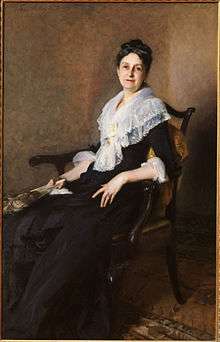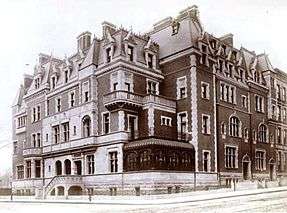Henry Gurdon Marquand
| Henry Gurdon Marquand | |
|---|---|
 John White Alexander, Henry G. Marquand, 1896, in the Princeton University Art Museum | |
| Born |
April 11, 1819 New York City |
| Died |
February 26, 1902 (aged 82) New York City |
| Nationality | United States |
| Occupation | Financier |
| Known for | Philanthropy to Princeton University and Metropolitan Museum of Art, Art collector |
| Spouse(s) | Elizabeth Allen Marquand |
| Children | Allan Marquand |
Henry Gurdon Marquand (April 11, 1819 – February 26, 1902) was an American financier, philanthropist and collector.
Early life

Marquand was born in New York City on April 11, 1819. The second youngest of the 11 children of Isaac and Mabel Perry Marquand, Henry began working for his family’s prestigious jewelry business, Marquand & Co., at the age of fifteen.[1] At the time, the business was headed by his older brother Frederick (1799–1882), a liberal benefactor of Yale College and of the Union Theological Seminary. Following the death of their father in 1838, Frederick sold the business and took up real estate investment and other financial ventures, and Henry his brother's agent. Marquand married Elizabeth Love Allen of Pittsfield, Massachusetts, on May 20, 1851.[1]
Career and philanthropy
Henry established himself as a banker on Wall Street, became Director of the Equitable Life Insurance Company, and made eventually a fortune speculating on foreign currency exchange and railroads. In 1867 Henry and his brother-in-law, Thomas Allen, bought a chief interest in St. Louis, Iron Mountain and Southern Railway which ran from St. Louis to southeast Missouri and to Arkansas and Texas. The two were ultimately pushed out of their investment by Jay Gould, whose monopoly on the southwestern railroad system forced them to sell. With a profit of one million dollars, Marquand effectively retired from the business world in 1880 and focused his energies on the acquisition of art and the management of the fledgling Metropolitan Museum of Art.[1] He was also the first honorary member of the American Institute of Architects.

Marquand was a member of the Provisional Committee of fifty men assembled in 1869 to establish a museum of art in New York City. As a member of the building committee and president of the Museum's board of trustees,[2] he witnessed the physical growth of the Metropolitan Museum of Art from various temporary quarters to its permanent home on the eastern edge of Central Park. Marquand, a personal friend and client of museum architect Richard Morris Hunt,[2] was in large part responsible for the realization of the project to extend and reorient the distinctive Beaux-Arts façade entrance east to Fifth Avenue, pushing for the plans to be carried out by Hunt’s son (Richard Howland Hunt) after the death of the renowned architect. Marquand was also a significant contributor to the Museum's collection, particularly in the area of European paintings.[3] This donation included, among other old master works, Johannes Vermeer's Woman with a Water Jug, the first Vermeer to enter a United States collection and which scholars now agree is one of only thirty-seven known works by the artist.[1]
Marquand was also a benefactor of the Metropolitan Museum of Art Schools[4] and Princeton University, donating funds for the creation of the Bonner-Marquand Gymnasium and the Marquand Chapel (the latter designed by Richard Morris Hunt).[5]
Death and legacy
He died in New York City at the age of 82. His varied, and valuable art collection and rare books were sold in 1903. He was a significant financial benefactor of The Metropolitan Museum of Art, Princeton University, and other institutions. His son, Allan Marquand (b. 1853), graduated from Princeton in 1874, and in 1883 became professor of archaeology and art.
References
- 1 2 3 4 Finding aid for the Henry Gurdon Marquand Papers, 1852-1903.
- 1 2 Heckscher, Morrison H. "The Metropolitan Museum of Art: An Architectural History." The Metropolitan Museum of Art Bulletin 53, no. 1 (Summer 1995): 1-80.
- ↑ New York Times (16 January 1889). "MR. MARQUAND'S GREAT GIFT.". Retrieved 11 July 2014.
- ↑ Finding aid for Schools of The Metropolitan Museum of Art Records (1879-1895). The Metropolitan Museum of Art. Retrieved 31 July 2014.
- ↑ Princeton University. "Princeton University: An Interactive Campus History, 1746-1996. Marquand Chapel". Retrieved 11 July 2014.
Further reading
- Kisluk-Grosheide, Danielle O. "The Marquand Mansion." Metropolitan Museum Journal 29 (1994): 151-181.
- Saltzman, Cynthia. Old Masters, New World: America’s Raid on Europe's Great Pictures, 1880-World War I. New York: Viking, 2008. ISBN 0-143-11531-6.
External links
- Digital Collection of the Henry Gurdon Marquand papers from The Metropolitan Museum of Art Libraries
- Henry Gurdon Marquand Papers finding aid from The Metropolitan Museum of Art Libraries
- Gilding the Gilded Age: Interior Decoration Tastes & Trends in New York City A collaboration between The Frick Collection and The William Randolph Hearst Archive at LIU Post.
- Young Woman with a Water Pitcher at The Metropolitan Museum of Art (89.15.21).
- Henry G. Marquand, portrait by John Singer Sargent. The Metropolitan Museum of Art (97.43).
| Cultural offices | ||
|---|---|---|
| Preceded by John Taylor Johnston |
President of the Metropolitan Museum of Art 1889-1902 |
Succeeded by Frederick W. Rhinelander |